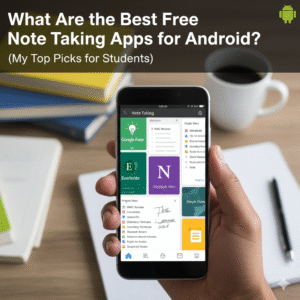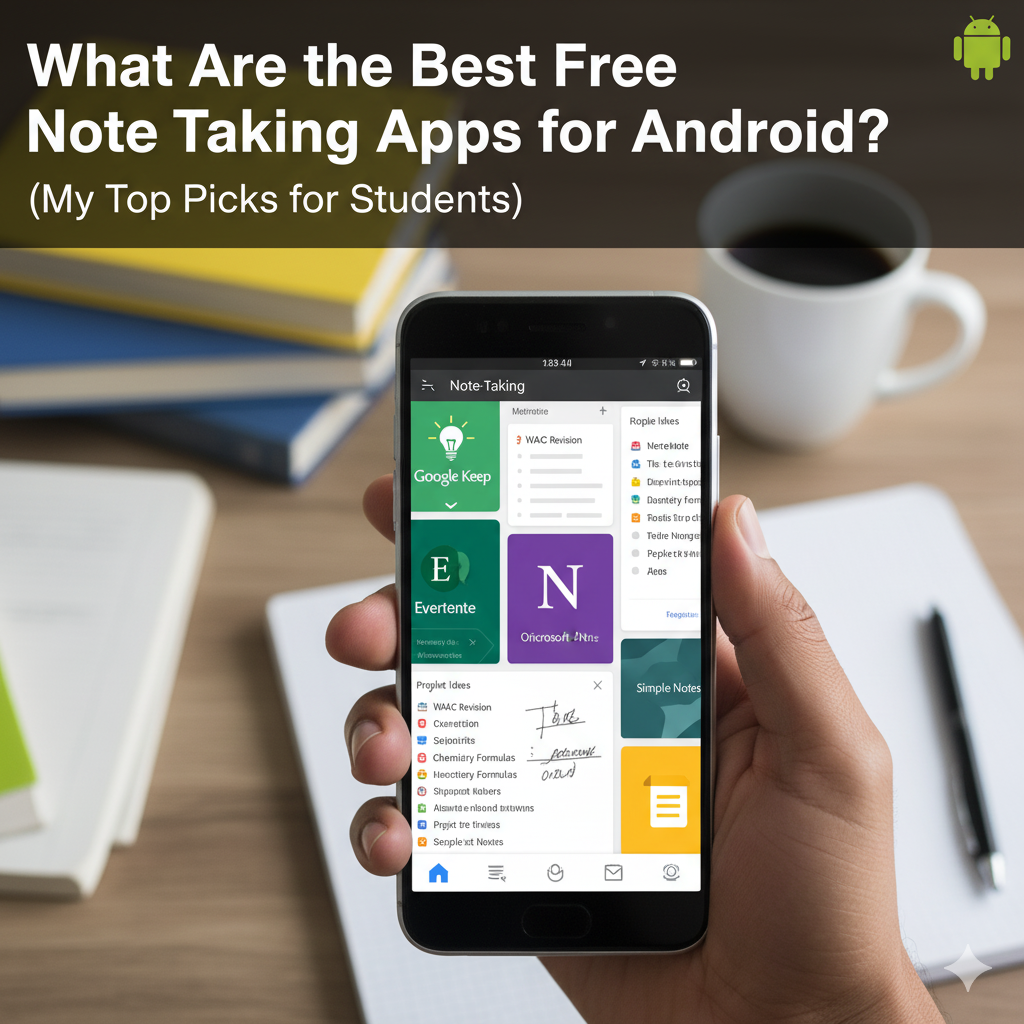What Are the Best Free Note Taking Apps for Android? (My Top Picks for Students)
What Are the Best Free Note Taking Apps for Android? (My Top Picks for Students)
Ever been in a lecture, and the lecturer is moving way too fast?
You’re trying to scribble everything in your jotter, but your hand is cramping, and the notes look like chicken scratch by the time you’re done. I’ve been there. A good app on your phone can be a lifesaver, but the Play Store is a crowded market.
The truth is, the single best free note taking app for android depends on how you study.
In this post, I’m cutting through the noise. I’ll share the apps I’ve personally used to survive uni, what they’re really good for, and (most importantly) what they’re bad for.

Why Your Old Jotter Isn’t Enough Anymore
Look, I love a good paper note. There’s something about writing by hand that helps with memory.
But let’s be real.
You can’t search a paper jotter at 2 AM when you’re cramming for an exam. You can’t back it up (spill one bottle of Zobo in your hostel room, and it’s gone). And you definitely can’t access your lecture notes when you’re in a cab stuck in traffic.
A good app solves all this. It syncs your notes from your phone to your laptop. It’s searchable. It’s always in your pocket.
My Top Picks for the Best Free Note Taking Apps for Android
I’ve tried dozens. Most of them are either too complicated or too simple. These are the ones that I think hit the sweet spot for Nigerian students.
1. Google Keep
This is probably already on your phone. I use Keep as my “digital brain dump.”
Did the lecturer mention a website? I pull out my phone, open Keep, and type it in two seconds. It’s perfect for checklists (like items to buy at the market) and quick, colourful sticky notes. It syncs instantly with your Google account.
The Honest Truth: It’s terrible for long, structured notes. Trying to organize your entire GNS 101 course in Keep will drive you mad. It’s for quick capture, not for building a library.
2. Microsoft OneNote
This is the heavyweight champion for serious students, and it’s completely free with any Microsoft account (which you can get easily).
Imagine your 5-subject notebook, but digital. OneNote lets you create “Notebooks” (like ‘My 200 Level Courses’), “Sections” (like ‘CSC 201’), and “Pages” (like ‘Lecture 1: Algorithms’).
You can type anywhere, draw, add voice notes, and even drop in PDFs of the lecturer’s slides. It’s a game-changer for organizing a whole semester.
The Honest Truth: It can feel a bit… big. It takes a minute to learn, and it’s not as “fast” as Google Keep for a quick idea. Sometimes the sync can be a bit slow if you have a bad network.
3. Simplenote
Do you get distracted by bells and whistles? Is OneNote too complex? Try Simplenote.
It’s exactly what the name says. It’s just text. Black and white. It is insanely fast and syncs across all your devices flawlessly. If you just want to type your notes in a clean, distraction-free space, this is it. It’s fantastic for drafting essays or writing code snippets.
The Honest Truth: It has zero features. No images. No checklists. No formatting (like bold or italics). If you are a visual learner who needs diagrams, avoid this completely.
4. Evernote
I have to mention Evernote. For years, it was the undisputed king. It can clip web pages, scan documents, manage tasks, and organize notes beautifully.
The Honest Truth: The free version is now very, very limited. As of my last check, you can only sync between two devices. For most students who have a phone, a laptop, and maybe a tablet, this is a deal-breaker. It’s still a great app, but the free plan has lost its power for me.
How I Actually Use These Apps to Study (My “Hybrid” Method)
Here’s a pro-tip: You don’t have to pick just one. I use a “hybrid” system that gets the best of both worlds.
- Step 1: In the lecture hall, I use Google Keep for fast capture. Lecturer says a key date? I type it in Keep. He mentions a book? Keep.
- Step 2: Back in the hostel, I open OneNote on my laptop. I move those quick ideas from Keep into my organized “CSC 201” notebook. This is where I flesh them out, add screenshots, and write my proper revision notes.
This way, I get the speed of Keep and the organization of OneNote.
The Biggest Mistake Students Make With Note Apps
Here’s the trap: thinking the app is the work.
You can have the most organized OneNote in the world, but if you just “collect” notes and never review them, you’re wasting your time. The app is a tool, not a magic solution. You still have to do the hard work of reading, summarizing, and testing yourself.
Are Paper Notes Dead? (The Honest Truth)
Absolutely not. In fact, for pure memory, paper is still king.
Studies, like those published by the Association for Psychological Science, often show that writing by hand forces your brain to process information differently, which can boost retention.
I still use a paper jotter for things I really need to memorize, like math formulas or complex definitions. The app is for organization and search; the paper is for deep learning.
Frequently Asked Questions (FAQs)
1. What’s the best app for scanning my paper notes? I’d recommend Microsoft Lens. It’s free, it’s brilliant at turning a photo of a whiteboard or a page into a clean PDF, and it integrates perfectly with OneNote. Google Drive’s built-in scanner is also very good.
2. Can any of these apps record the lecture? Yes, OneNote and Evernote both have built-in audio recording. But please: always ask your lecturer for permission before you record them!
3. What if I don’t have much data or space on my phone? Get Simplenote. It’s tiny (only a few MBs) and uses almost no data to sync because it’s just text.
4. Are these apps better than just using Google Docs? For notes, yes. Google Docs is designed for writing long essays. Note apps are designed for organizing and connecting many small pieces of information, which is what you need for studying.
5. What’s the best app for drawing diagrams or for a stylus? OneNote is the best free option here. It has good drawing tools. If you’re really serious about handwriting, many people use an app called Squid, but OneNote is the best all-in-one package.
My Final Thoughts
So, what’s the verdict?
Don’t waste time looking for one “perfect” app. The best system is often a mix. Start simple. If you’re disorganized, try OneNote. If you’re just messy and need a place for quick ideas, start with Google Keep.
The best free note taking app for android is the one you actually open and use every day. Pick one from this list, stick with it for one week, and see if it works for your brain.
What do you use? Did I miss your favourite app? Let me know in the comments!








2 Comments